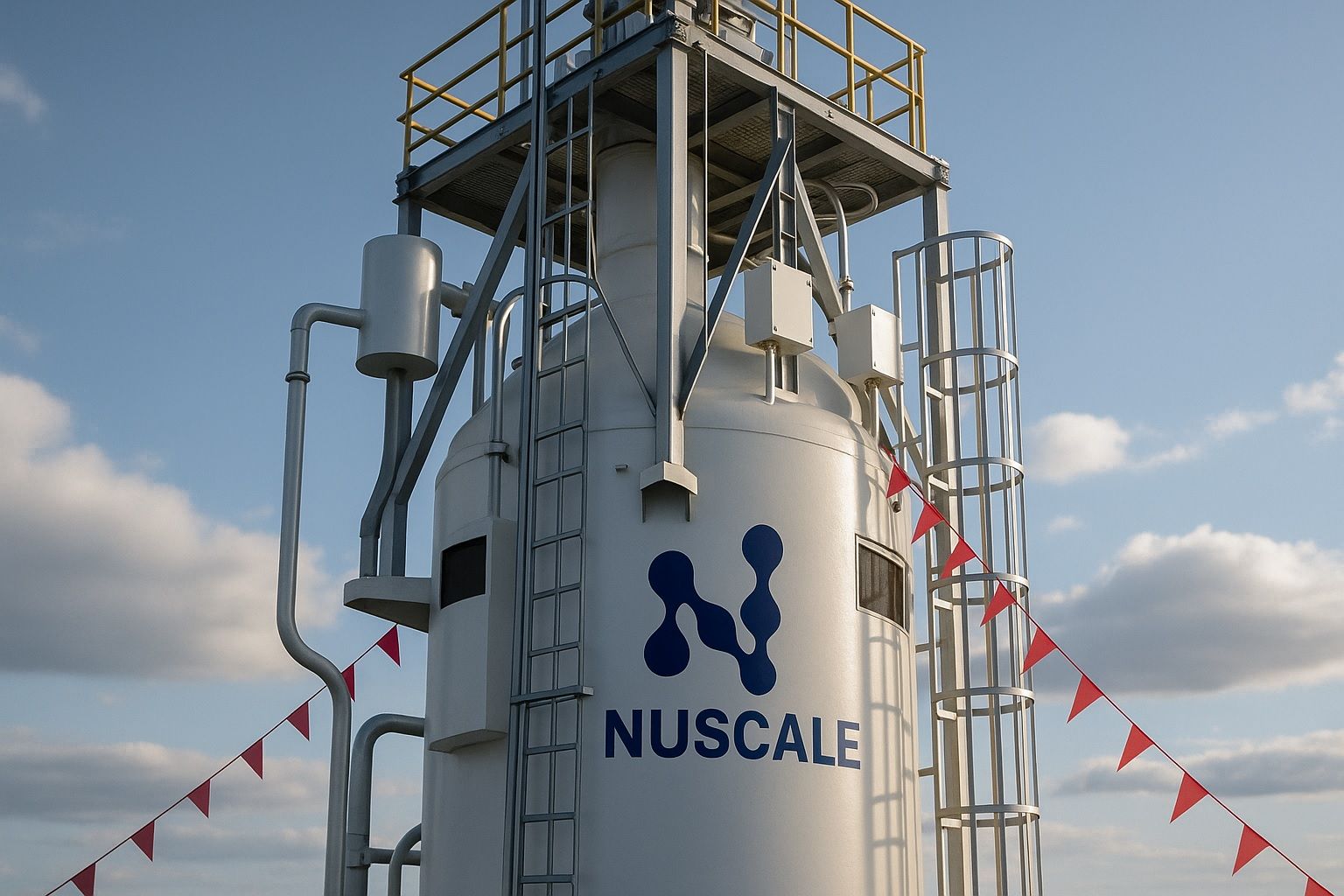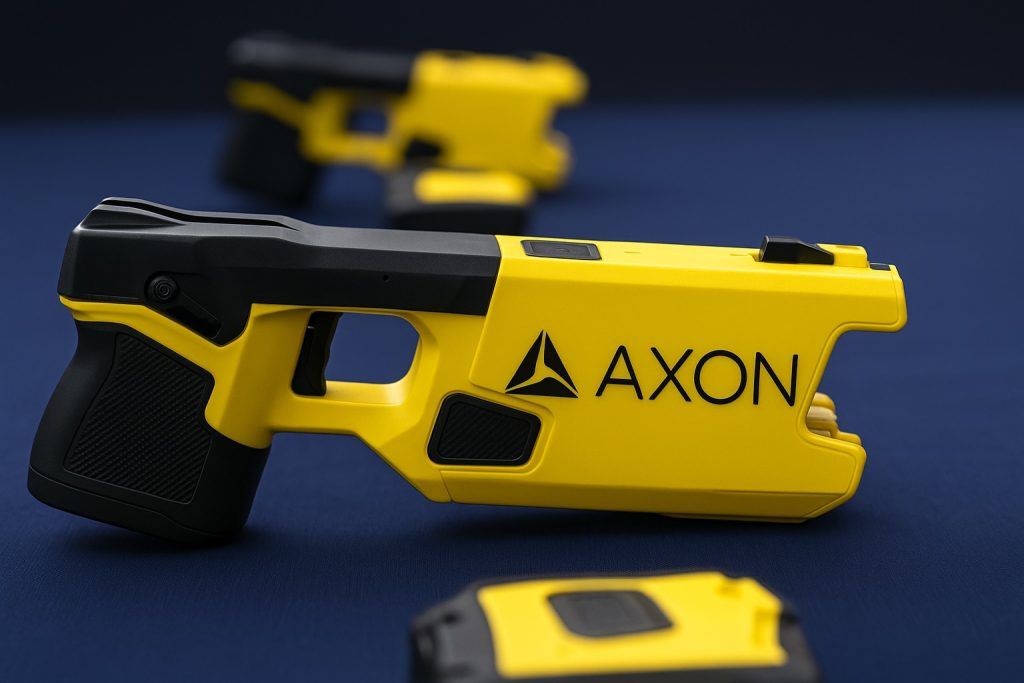- NuScale Power (NYSE: SMR) shares surged ~20% this week after its partner ENTRA1 inked a 6 GW small modular reactor (SMR) deployment deal with the Tennessee Valley Authority – touted as the largest SMR project in U.S. history [1]. The stock jumped ~14% intraday on Oct. 13 and hit around $55 by Oct. 15 (up 20% from prior close) on the historic contract news [2].
- U.S. Army backs micro reactors: Investor enthusiasm for nuclear got another jolt as the U.S. Army launched a program to deploy small “microreactor” nuclear plants on domestic bases by 2028, aiming for up to a dozen mini-reactors in the next few years [3] [4]. This government push underscores rising official support for advanced nuclear tech.
- GE Vernova’s nuclear push:GE Vernova – General Electric’s energy spinoff (NYSE: GEV) – is racing to deploy SMRs with its 300 MWe BWRX-300 reactor. In September, GE partnered with Hitachi and Samsung to sell BWRX-300 reactors globally (with five units proposed in Sweden) [5]. GE Vernova’s stock has climbed ~97% year-to-date (vs. +151% for NuScale) [6], though Zacks rates GEV a “Sell” (vs. NuScale “Hold”) amid headwinds in GE’s wind-turbine business [7].
- Analysts urge caution on NuScale:Wall Street sees NuScale as a first-mover – it has the only NRC-certified SMR design in the U.S. [8] – but most analysts rate SMR stock Hold, and their average 12-month target (~$38–$42) sits well below the current price [9]. They warn NuScale’s valuation is stretched (forward P/S ~85× vs ~4× for GE Vernova) [10] even as NuScale pursues its first revenues.
- Nuclear revival gains steam: Governments and industry are betting on SMRs to meet surging 24/7 power needs. The U.S. recently extended nuclear tax credits and streamlined reactor licensing [11], while countries like Italy and Poland move to restart nuclear projects (including advanced SMRs). Market researchers project the global SMR market could grow to $15–20 billion by 2030 [12] – but realizing that potential depends on successful execution of new reactor projects.
NuScale’s Historic SMR Deal Sparks a Nuclear Stock Rally
NuScale Power’s stock is on fire after the company secured a massive 6 gigawatt SMR deployment program with the Tennessee Valley Authority (TVA) – “the largest SMR deployment in U.S. history,” according to NuScale [13]. The deal, executed via NuScale’s ENTRA1 Energy venture, will see up to six 77 MWe modular reactors installed in TVA’s service area, enough to power ~4.5 million homes and dozens of data centers [14]. Investors cheered the news: on October 13, SMR shares spiked ~14% intraday, and by mid-week the stock was trading around $55 – roughly 20% higher than last week’s close [15]. This caps a remarkable run in 2025: NuScale has now more than tripled in value since early January [16].
The 6 GW TVA agreement is a breakthrough milestone for NuScale. Not only is it a multi-reactor pipeline worth billions, it’s a marquee endorsement of the company’s small modular reactor technology. NuScale’s SMR design – a factory-built, 77 MWe light-water reactor module – is the first (and so far only) SMR to receive U.S. Nuclear Regulatory Commission certification [17]. Company officials hailed the TVA project as transformational. “This is a historic moment for clean, reliable energy,” said NuScale CEO John Hopkins, who calls the SMR a “proven technology” that will deliver “clean, reliable, and…safe” power [18]. The TVA deployment (targeted around 2030) aims to provide carbon-free baseload electricity for AI data centers and critical industries, addressing surging 24/7 power demand in the digital economy [19] [20].
Broader momentum in the nuclear sector amplified NuScale’s rally. Just a day before the stock pop, the U.S. Army and Department of Energy unveiled “Project Janus,” a new program to install small nuclear reactors on Army bases. Announced at the AUSA defense conference on Oct. 14, the initiative’s goal is to have a prototype microreactor running by next summer and at least one operational on a base by 2028 [21] [22]. These truck-portable “microreactors” – providing a few megawatts each – would bolster energy security for military installations independent of vulnerable civilian grids [23] [24]. Army officials framed it as a strategic necessity: “We’re going to need power like we have never needed it before…this is our first big step toward pushing forward nuclear energy for our country,” said Army Secretary Dan Driscoll [25]. For investors, the Army’s move served as yet another signal that small-scale nuclear reactors are gaining high-level support, adding fuel to the SMR stock boom.
This optimism isn’t confined to the U.S. – it’s increasingly global. In Europe, Italy’s government recently moved to reintroduce nuclear power (including advanced modular reactors) after a decades-long ban, sparking a spike in NuScale’s stock [26]. Meanwhile, Sweden’s Vattenfall shortlisted GE Vernova’s SMR design (and a Rolls-Royce rival) for a major new reactor order [27], and countries from Romania to Canada are exploring SMRs to hit climate targets. Even tech giants are on board: Alphabet (Google) CFO Ruth Porat has argued that “nuclear has to be a part of the mix” to meet future energy needs [28]. From governments eyeing energy security to cloud computing firms hungry for reliable power, nuclear energy is staging a revival – and NuScale’s big win positions it at the forefront of this trend.
GE Vernova Enters the Fray with SMRs of Its Own
GE Vernova, General Electric’s dedicated energy company (spun off in 2024), is determined not to be left behind in the SMR boom. GE Vernova’s nuclear division (a joint venture with Hitachi) has developed the BWRX-300, a 300 MWe small modular reactor roughly four times the size of NuScale’s units. In early October, GE Vernova announced a strategic alliance with Samsung C&T to deploy the BWRX-300 globally, highlighting the design’s international appeal [29]. As part of that alliance, a Swedish utility is evaluating a fleet of five BWRX-300 reactors to meet Sweden’s clean power needs [30]. “This partnership underscores GE Vernova’s push into the nuclear sector,” noted GE’s announcement, which casts the BWRX as a key growth driver in the company’s transition to carbon-free energy [31].
In the U.S., GE Vernova is also making headway. The Tennessee Valley Authority has formally accepted GE’s SMR design for its Clinch River site in Tennessee [32] – the same utility that inked NuScale’s deal is hedging bets by pursuing GE’s reactor in parallel. GE Hitachi’s BWRX-300 is further along in some respects: a first unit is under construction in Ontario, Canada, slated to be one of the world’s earliest grid-connected SMRs. GE Vernova executives cite a “robust pipeline” of inquiries from utilities worldwide, and the company is actively pitching its reactor to Eastern Europe and Asia as well [33] [34].
For GE Vernova, SMRs are one part of a much larger energy portfolio – which comes with advantages and challenges. On the upside, GE Vernova can leverage its global energy infrastructure footprint and decades of reactor experience (through legacy GE Hitachi Nuclear Energy) to deploy SMRs at scale. The company also secured a $14.2 billion deal with Saudi Arabia in May to supply gas turbines and power equipment [35], boosting its revenues and demonstrating its reach in big energy projects. Wall Street has taken notice: GE Vernova’s stock has soared from around $330 at the start of 2025 to about $640 recently [36] – a ~80% jump this year. As of Oct. 13 the stock closed at $646.61 [37], giving GE Vernova a hefty ~$70 billion market capitalization.
However, GE Vernova’s broad business also brings baggage. Its renewable energy division (particularly wind turbines) has struggled with slim margins and high costs, which are weighing on overall profitability [38]. In fact, GE Vernova’s wind unit faces hundreds of millions in rising costs and tariffs in 2025, leading some analysts to temper their outlook [39]. This divergence is reflected in recent analyst ratings: research firm Zacks gave GE Vernova a “Sell” rank (citing those wind business headwinds) while assigning NuScale a Hold, effectively viewing SMR pure-play NuScale as a relatively stronger bet in the nuclear space [40]. Still, many analysts remain bullish on GE Vernova’s long-term prospects. Investment bank Susquehanna, for example, lauds GE Vernova’s “robust backlog” of projects and favorable policy tailwinds, recently issuing a $740 price target for the stock – well above current levels [41]. The consensus on GE Vernova is around a Moderate Buy, with an average target near $600 [42], as analysts expect its revenue and earnings to improve. (GE Vernova is set to report Q3 earnings on Oct. 22, with Wall Street forecasting a ~409% YoY EPS jump on rising sales [43].) Even so, valuation is a concern: GE Vernova trades around 142× forward earnings, far above the industry average ~28× [44], an indication that a lot of optimism is already priced in. A discounted cash flow analysis suggests the stock’s fair value is roughly $613 – in line with its current price [45] – meaning future gains will hinge on the company delivering growth to justify its premium. In short, GE Vernova offers a broad “energy transition” play (from wind turbines to grid equipment to nuclear reactors), but investors will be watching how it balances its wind woes against the promise of SMR projects.
Hype vs. Reality: What Experts Say About NuScale and Nuclear Stocks
There is no doubt that excitement is sky-high for advanced nuclear companies – sometimes verging on speculative hype. Alongside NuScale’s surge, other nuclear startups have seen eye-popping gains. For instance, California-based Oklo Inc. (NYSE: OKLO) – an early-stage developer of microreactors – has seen its stock skyrocket over 500% in 2025, recently hitting an intraday high of ~$146 per share [46]. Oklo’s 1,200% year-over-year jump and $20 billion market cap illustrate how investors are piling into the “next big thing” in nuclear, betting on a potential “Tesla of nuclear” [47]. “AI power boom” hype has turned next-gen nuclear stocks into a frenzy, Bloomberg observed, noting that Oklo’s 1000%-plus rally and NuScale’s own tripling share price have made the sector a “market obsession” [48]. It’s clear that speculative fervor – driven by hopes that advanced reactors will solve both climate and energy needs – is inflating valuations across the board.
Industry experts and analysts are divided on how much of this enthusiasm is justified. On the bullish side, many point to concrete progress and unique advantages that companies like NuScale have achieved. NuScale’s regulatory milestones (NRC design approval) and big-name partnerships put it “at the industry leader” position in SMRs [49]. “Utilities see SMRs as crucial to provide round-the-clock carbon-free power in the AI era,” notes one industry analysis [50] – and NuScale now has a marquee utility project (TVA’s 6 GW program) to underpin its outlook [51]. The U.S. government is heavily funding advanced reactors and has extended production tax credits for nuclear, suggesting years of tailwinds for the sector [52]. Wall Street bulls also emphasize NuScale’s first-mover advantage: it is the only U.S. SMR vendor with design certification, giving it a regulatory lead of potentially several years over competitors [53]. “NuScale’s SMR tech breakthroughs and key partnerships give it an edge,” says Marcin Frąckiewicz, a strategist at TechStock² [54]. And as noted, major tech companies are voicing support – Google’s CFO publicly stressed the need for nuclear in the energy mix for exactly the kind of power NuScale will provide [55]. All this lends credibility to the idea that a “new nuclear age” is emerging, as one Canaccord Genuity analyst put it, with advanced reactor firms poised to benefit [56].
On the other hand, realism (or skepticism) abounds regarding the near-term investment case. NuScale may have a bright future, but for now the company continues to lose money – burning about $95 million in cash each quarter as of mid-2025 [57] – and has yet to generate revenue from reactor sales. Its first commercial plant is at least five years away (targeted around 2030), and history shows nuclear projects often run over-budget and behind schedule. In fact, NuScale canceled its flagship six-module Idaho project in 2023 after cost estimates nearly doubled, a sobering reminder that even “small” reactors face big engineering and finance challenges [58] [59]. “SMRs will be very expensive initially,” warns nuclear consultant Jeffrey Bonner, noting that the first movers must build out supply chains and won’t achieve economies of scale until many units are deployed [60]. There’s also execution risk: NuScale’s CEO has candidly acknowledged that the company has not yet secured a U.S. data-center customer for its reactors, despite marketing heavily to that sector [61]. If anticipated customers (utilities, data center operators, industrial users) don’t sign on the dotted line in coming years, NuScale’s lofty valuation would be hard to sustain [62].
Analysts are waving yellow flags about valuations. Zacks Investment Research recently noted that over the last three months, NuScale’s stock (+12.7%) actually lagged peers like GE Vernova (+17.6%) and Nano Nuclear (+35.3%) [63]. This underperformance, despite big headlines, suggests that NuScale’s rich pricing may be limiting further upside. At current levels, SMR trades at an 80–85× forward price-to-sales ratio [64] – an eye-watering multiple that assumes huge growth to come. By contrast, GE Vernova’s diversified business sports a ~4× P/S [65], reflecting actual revenue streams today. Not surprisingly, most Wall Street analysts covering NuScale are holding a neutral stance. According to MarketBeat and TradingView aggregates, around 15 analysts have a consensus Hold on SMR [66]. Their median 12-month price target is in the $37–$40 range [67] – which is 25–30% below the recent ~$55 share price. In other words, the street generally believes NuScale’s stock has gotten ahead of its fundamentals. Zacks currently assigns NuScale a #3 rank (Hold) and explicitly suggests waiting for a pullback before buying [68]. Even bullish analysts urge some caution until NuScale proves it can execute. “There is a lot of expectation baked in” at these prices, one Motley Fool writer observed, advising that more concrete progress – like an actual SMR in operation – may be needed to fully justify the valuation [69]. The same tone surrounds Oklo and others: after Oklo’s 500% surge, the consensus rating on that stock is also Hold and the average target (~$85–$90) implies significant downside [70] – a sign that many see a bubble in the most speculative nuclear names.
Outlook: A Nuclear Renaissance in the Making – But Mind the Risks
Looking ahead, the stage is set for a potential nuclear energy renaissance not seen in decades. On the demand side, the need for reliable, carbon-free power is accelerating. Utilities and governments are turning back to nuclear to replace fossil fuels and provide steady baseload power alongside intermittent renewables. The rise of AI supercomputing and large data centers is a game-changer – these facilities require enormous 24/7 electricity, and SMRs are increasingly seen as an ideal solution for powering “AI hubs” with zero emissions [71]. It’s telling that the TVA, in pursuing NuScale’s reactors, explicitly cited future AI data center growth in its region as a motivator [72] [73]. On the policy side, support is robust. The U.S. government has put real money on the table via tax credits (the 2025 energy legislation expanded incentives for nuclear power [74]) and through direct investment – from funding fusion and SMR projects to the Army’s new reactor program. Globally, previously anti-nuclear countries (e.g. Italy, Japan) are reconsidering nuclear energy in light of energy security and climate goals [75]. Dozens of SMR projects are in planning across Canada, Europe, and Asia, many involving Western companies like NuScale or GE Hitachi. This all suggests a healthy pipeline of opportunities: as analysts note, NuScale’s big 6 GW deal is likely the first of many, with similar initiatives emerging in Poland, Romania, and elsewhere [76]. In short, the long-term narrative for SMR developers is compelling – they could be at the forefront of a multibillion-dollar clean energy market over the next decade [77].
The open question is whether today’s stock prices have run too far ahead of that reality. Building new nuclear plants – even smaller, modular ones – remains a lengthy, capital-intensive endeavor. NuScale, for example, does not expect to turn profitable until around 2030, when its first plants should come online [78]. That timeline means investors must be patient and have faith that no major delays or cost overruns derail the projects. Any slip-ups (regulatory hiccups, supply chain bottlenecks, construction delays) could sour market sentiment quickly. “Past SMR ventures have stumbled,” industry observers warn, recalling the abandoned Idaho project and other early-stage failures [79]. Execution risk is especially high for first-of-a-kind deployments – something as simple as a manufacturing delay for a critical component could push schedules out by months or years. Furthermore, while NuScale’s 6 GW TVA contract is huge, it’s not yet a firm order for reactors – much depends on feasibility studies and financing over the next few years [80]. Investor psychology could also introduce volatility: after such a steep climb, NuScale’s stock might not sustain its momentum without continual “good news” (new deals, regulatory wins, etc.) [81]. As Zacks noted, if SMR shares retreat toward the ~$37–$40 range, some bargain hunters may step in [82] – but a sustained rally from here likely needs fresh catalysts to support it.
All that said, many analysts and industry veterans still believe we are at the inflection point of a nuclear renaissance. The convergence of technology improvements, climate urgency, and now high-profile endorsements (even the U.S. Army) is giving nuclear energy a legitimacy and momentum it hasn’t enjoyed in decades. “NuScale appears to lead the SMR boom,” said TechStock²’s Frąckiewicz, thanks to its head start in approvals and contracts [83]. But, as he and others quickly add, investors should “weigh [NuScale’s] lofty valuation” against the long road to revenue [84]. In other words, promise and potential are abundantly present – but proof and profits are still on the horizon. For now, NuScale’s soaring stock and GE Vernova’s hearty rally show that Wall Street clearly believes in the future of nuclear. Whether these companies can deliver on that future fast enough to justify today’s prices will be the ultimate test. As one financial columnist quipped, advanced nuclear could light up the world – or burn investors – and it’s likely to be a bit of both in the volatile journey ahead.
Sources: Recent news reports and expert analysis from Motley Fool, Zacks, TS2.tech, Reuters, National Defense Magazine and company releases [85] [86] [87] [88] [89], as well as stock data as of Oct. 14–16, 2025 [90] [91].
References
1. ts2.tech, 2. ts2.tech, 3. www.nationaldefensemagazine.org, 4. www.nationaldefensemagazine.org, 5. ts2.tech, 6. ts2.tech, 7. ts2.tech, 8. ts2.tech, 9. ts2.tech, 10. ts2.tech, 11. ts2.tech, 12. ts2.tech, 13. ts2.tech, 14. ts2.tech, 15. ts2.tech, 16. ts2.tech, 17. ts2.tech, 18. ts2.tech, 19. ts2.tech, 20. ts2.tech, 21. www.nationaldefensemagazine.org, 22. www.nationaldefensemagazine.org, 23. www.nationaldefensemagazine.org, 24. www.nationaldefensemagazine.org, 25. www.nationaldefensemagazine.org, 26. ts2.tech, 27. www.reuters.com, 28. ts2.tech, 29. www.ainvest.com, 30. ts2.tech, 31. www.ainvest.com, 32. ts2.tech, 33. ts2.tech, 34. ts2.tech, 35. www.ainvest.com, 36. www.ainvest.com, 37. www.ainvest.com, 38. ts2.tech, 39. ts2.tech, 40. ts2.tech, 41. www.ainvest.com, 42. www.ainvest.com, 43. www.ainvest.com, 44. www.ainvest.com, 45. www.ainvest.com, 46. ts2.tech, 47. ts2.tech, 48. ts2.tech, 49. ts2.tech, 50. ts2.tech, 51. ts2.tech, 52. ts2.tech, 53. ts2.tech, 54. ts2.tech, 55. ts2.tech, 56. ts2.tech, 57. ts2.tech, 58. ts2.tech, 59. ts2.tech, 60. ts2.tech, 61. ts2.tech, 62. ts2.tech, 63. ts2.tech, 64. ts2.tech, 65. ts2.tech, 66. ts2.tech, 67. ts2.tech, 68. ts2.tech, 69. finviz.com, 70. ts2.tech, 71. ts2.tech, 72. ts2.tech, 73. ts2.tech, 74. ts2.tech, 75. ts2.tech, 76. ts2.tech, 77. ts2.tech, 78. ts2.tech, 79. ts2.tech, 80. ts2.tech, 81. ts2.tech, 82. ts2.tech, 83. ts2.tech, 84. ts2.tech, 85. ts2.tech, 86. www.nationaldefensemagazine.org, 87. ts2.tech, 88. ts2.tech, 89. ts2.tech, 90. ts2.tech, 91. www.ainvest.com







